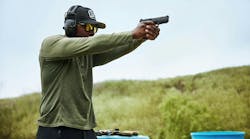No one disagrees that police officers, in order to do their jobs properly, successfully and safely, have to be in peak physical condition.
In fact, every police force on the planet has minimum physical standards that recruits have to meet and a test that they all have to pass. Don’t pass the test and you don’t become a police officer.
That’s how important physical condition is.
At least at the beginning.
Where the challenge comes in is after recruits pass the test and become full-fledged police officers. Many departments don’t have any sort of on-going physical fitness testing of any kind. This is directly opposite of how departments handle firearms certification – in most cases, officers have to re-qualify for firearms periodically.
“There is a rub between labor and management,” acknowledges Jay Smith, president and CEO, FitForce, Inc., a physical readiness solutions company. “In public safety, we have this practice that a basic physical ability is so basic you have to pass and then once you are hired you are never tested again.
“Management perceives the issue as divisive, fraught with legal and technical peril, and often insurmountable due to resistance, cost and a general lack of knowledge,” he continues. “Labor, particularly in areas with strong collective bargaining units, sees fitness the same way, through their own lens colored by a need to protect themselves and their livelihood. Both sides also share the perception that the other should do something about fitness and that in any event, fitness will be there when it’s really needed because after all, bad things only happen to other people.”
The importance of physical conditioning
The benefits of fit officers are many. “As is true for everyone, fit and healthy officers will feel better and perform better,” says Roberto DiGiulio, full time trainer for the City of Hillsboro (Oregon) Police Department. “Fitness and well-being are correlated with better mood, better cognitive function, less sick days and higher subjective ratings of vitality. It's hard to think of a part of an officer's job that will not be affected by these improvements.”
Determining the concrete returns of a fitness program, however, is a long term strategy. “The tangible benefits of a fit police force are decreased absenteeism, fewer injuries due to non-line of duty accidents – so called ‘trip and fall’ or bending over to tie my shoe stuff,” says FitForce’s Smith. “Return on Investment is estimated on average to be $3.14/$1.00 invested in an employee-centered program, though some industry estimates go up as high as $8-$9/$1 invested. One department employed voluntary health screens and identified five officers with risk so high they were sent immediately to their primary care physicians. Statistically, the likelihood was very high that two to three of those five were due to coronary heart disease–related risk. Since the estimated cost of an in-service heart attack is over $500,000, that agency and those officers dodged some scary bullets.
“More difficult to quantify benefits are increased productivity, decreased duration of disability due to line of duty injury, improved morale, improved public perception of the department and its officers and improved officer self-confidence, self-perception, personal stress management,” he adds.
Fitness goes beyond the workplace, however. “The benefits of fitness are farther reaching than just job performance,” says Kelly Kennedy, PhD, CSCS, CISSN, HFS, Fit to Enforce. “When we think of quality of life, incidence of injury, cost of sick time, back injuries, use of force...the list goes on. We want our kids to eat healthy and workout, why not for ourselves? We also want to know when our families call upon law enforcement for help, they get a competent and fit cop that can take care of things for them.”
The challenges
Many departments emphasize health and fitness at the academy level, but once officers pass, there is little or no emphasis, support or continued training.
“Generally, academy students are housed at their respective academies and their entire day is spent learning all things related to law enforcement,” says DiGiulio of the Hillsboro (Oregon) Police Department. “The curriculum is fairly holistic and officer's physical and emotional well-being is addressed with the hope this will ultimately help develop a better officer. Once an officer returns to their department there are competing interests for the officer's work time. Unfortunately dedicating time to officer's fitness is sometimes seen as competing with an officer's productivity. This is both sad and inaccurate as there is an increasing body of research showing a direct correlation with fitness/wellness and productivity.”
The experts agree that policy needs to be made, and that is where the problems arise. “Strong, enforceable policy supported by empirical evidence and sound knowledge is needed,” says FitForce’s Smith. “It all starts with the job. If a policy or an employment requirement is to be defensible, it must be demonstrably job related for the position in question and consistent with business necessity. Job relatedness is documented with evidence professionally collected and reported. Consistency with business necessity is evident when the department undertakes the means necessary to ensure its personnel maintain the ability to do the job.
“If a job has a physical dimension to it, the agency has a responsibility to ensure those in the job can do the job,” he continues. “A hiring policy should state a minimum level of physical ability is necessary to safely and effectively perform the essential functions of the job, whenever, wherever, at a moment’s notice, therefore, the agency will support, educate, and test for that physical ability and the officer will participate, comply and demonstrate that physical ability for the duration of their career. The policy is agreed to by all parties, as evidenced by signatures collected during the hiring phase. (Firearms qualification and use is an often cited analogy.)”
The emphasis on health and fitness has to come from the leaders of the agencies. “The biggest challenge is creating a culture that supports fitness from the top down,” says Fit-to-Enforce’s Kennedy. “In the military, fitness is part of the entire operational structure and is not considered an optional choice. Somehow in the law enforcement community, fitness is only supported for subordinates when immediate supervisors make it a part of their daily routine. At the academy level, the more we emphasize fitness, the more opportunity there is to teach the transformative effect it has on quality of life. Job performance should not be the only reason we encourage fitness. We should make it a part of the sales pitch to law enforcement so they can live out their retirement years and enjoy their lives outside of work.
“Departments are reluctant to establish any requirements because they do not want to risk a lawsuit for requiring a standard that cannot be defended in a lawsuit,” she continues. “There are several reputable companies that help establish those standards in a way that would be more defensible in a court of law, but that is costly and can be time consuming. Departments want established standards in fitness, but when they draw a line in the sand as to what they think is acceptable, they risk good officers not passing for something that later on was decided not essential to the job and end up in court. In the end, they just allow officers a space to work out but no time to do it...it is just an evil cycle.”
The Brentwood (TN) Police Department does things a little bit differently. According to the administrator of the fitness program, Sgt. Nick Surre, also co-founder of LEO-fit, their program is “a mandatory participation bi-annual fitness assessment. Mandatory participation meaning you must complete and give your best effort, but there are no negative effects if officers do not pass,” he details. “However, there are incentives to pass. When we started the program in 2012, we identified several key issues in order to make it successful.
- It must be a positive incentive program
- It must pay officers to complete assessment
- It must have High ranking command staff lead by example in fitness
- It must establish fitness assessment as a hiring standard
- It must provide a good workout facility available 24 hrs a day
- It must provide the tools to the officers in order to be successful
“Since October 2013 we have completed three fitness assessments (every six months) and we have seen a steady increase in officers passing the assessment,” he concludes.
What departments can do about it
Officer health and fitness won’t happen by chance, it has to be planned for, implemented and followed up. “If departments want fit officers, they must prioritize fitness,” says Hillsboro PD’s DiGiulio. “Exercise is deliberate and it won't happen by accident. If health, fitness, and wellness are an afterthought in a department, they will be an afterthought for the officers. In order to make fitness a priority we need to focus on the vicarious benefits to the community which officers serve.
“First it is vital for any department to understand the overwhelming research data correlating fitness/wellness with better mood, better cognitive function, less sick days, and higher subjective ratings of vitality,” he continues. “Once these truths are understood, a department will realize resources spent in this endeavor will reap great rewards. Once we have that level of commitment to understand why we are doing it, then I suggest a department reach out and seek information on how to do it. Our department entered a partnership with an internationally known trainer, Jason Seib, specifically because he has designed a holistic program which takes into consideration the unique challenges Law Enforcement Officers face daily. He has created a fitness, nutrition and stress management program that is both achievable and relevant.”
Start with analysis, advises FitForce’s Smith. “This is less costly and the results should inform the rationale and process of responding to the findings,” he explains. “Analyze the physical demands of the job: A job analysis is the basis for all employment practices, i.e. policy/procedure, job descriptions, training, hiring/retention/return to duty/disability/retirement. Analyze the needs of the department and its workforce: take a structured approach to a needs analysis and develop a plan to address those needs. One of my other hats is Strength and Conditioning Coach and this is the approach I take with athletes as well. I start with a whole bunch of questions, see if I need more information, review the results, verify the interpretation is correct, and then formulate a planned response.”
Even though an officer’s work day is jam packed to begin with, departments should make fitness time a regimented part of that day. “Departments should be allowing officers to maintain fitness on the job,” says Fit-to-Enforce’s Kennedy. “It should be built into the work week and encouraged rather than having to somehow sneak around on a break to work in a quick set.”
Changing perception
There are signs that health and fitness is becoming a greater concern for law enforcement. “When I started in law enforcement fitness training, I only knew of one other person with my background working at a police department (the person who I replaced) but they were not working with the academy,” says Kelly from Fit-to-Enforce. “At that time, there were some problems with injury trends and my department asked me to start working with the recruits to help reduce that - I have been there for 15 years now. There are now two national conferences on fitness for the law enforcement training population and I have met several other trainers that are now working with other law enforcement departments in a similar capacity. So I see the future in fitness training as rather bright. I hope that momentum keeps on building.”
Hillsboro PD’s DiGiulio believes we will see a time when fitness/wellness programming will become mandatory for police officers. “The growing research will bring to light the tangible benefits officer fitness/wellness will have on the law enforcement communities,” he says. “On the programming side, I believe we will see an increase of holistic wellness curriculum which will focus on physical, mental and emotional wellness.”
With more emphasis on healthy living in our general culture, the thinking is that this will transfer into the law enforcement culture as well. “I’m a glass half-full guy,” says FitForce’s Smith. “For a long time I’ve said the bigger picture of our culture as a whole would suggest a positive prognosis. I’m not so sure that’s still the case. The fitness levels of young people entering the profession, the general willingness to do the hard stuff sometimes, and the current inertia that exists in many departments are all coming together to suggest a less than positive future. On the other hand, we are currently in the middle of an unprecedented amount of scrutiny and activity from the courts. In my 25 year career, we have never seen as much litigation around basic issues that have long remained unresolved. We may be shaping the future now with the litigation beginning or under review.”



